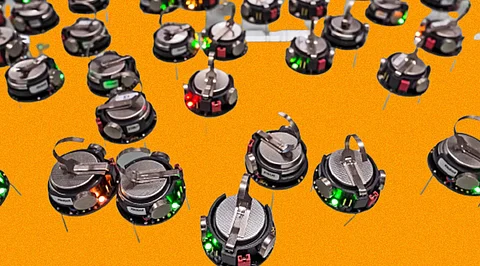
- InsightsInsights
- CryptocurrenciesCryptocurrencies
- Stocks
- White Papers
- IndustryIndustry
- GeographyGeography


In swarm robotics, multiple robots collectively solve problems by forming advantageous structures and behaviors similar to the ones observed in natural systems, such as swarms of bees, birds, or fish. However, the step to industrial applications has not yet been made successfully. Literature is light on real-world swarm applications that apply actual swarm algorithms. Typically, only parts of swarm algorithms are used which are referred to as basic swarm behaviors. The small size and wireless actuation of microrobots make them potential candidates for minimally invasive medicine. To advance microrobots to future clinical applications, micro-robotics researchers have investigated several key issues, in which swarm control is a primary challenge and is attracting increasing attention. As a single microrobot has limited volume and surface area, clinically relevant tasks, including in-vivo tracking, usually require simultaneous control of a large swarm of microrobots.
Unlike macroscale robots, implementing on-board actuators and sensors for microrobots is challenging, which differentiates swarm microrobotics from other swarm robotics approaches. In swarm robotics, multiple robots homogeneous or heterogeneous are interconnected, forming a swarm of robots. Since individual robots have processing, communication, and sensing capabilities locally on board they can interact with each other, and react to the environment autonomously.
Swarms typically consist of many individuals, simple, and homogeneous or heterogeneous agents. They traditionally cooperate without any central control and act according to simple and local behavior. Only through their interactions, a collective behavior emerges that can solve complex tasks. These characteristics lead to the main advantages of swarms: adaptability, robustness, and scalability. Swarms can be considered as a kind of quasi-organism that can adapt to changes in the environment
Researchers have successfully created molecular robots capable of swarming together to accomplish tasks together about five times more efficiently than individual "microrobots" could. At six micrometers in length and 25 nanometers in diameter, each of these robots is invisible to the human eye. But with a design combining robotics and biological engineering, scientists were able to make 5 million of these molecular robots work together to deliver beads of polystyrene, the polymer perhaps best known for its use as Styrofoam and in packing peanuts.
In most swarm algorithms, individuals perform according to local rules and the overall behavior emerges organically from the interplay of the individuals of the swarm. Translated to the swarm robotics domain, individual robots exhibit a behavior that is based on a local rule set which can range from a simple reactive mapping between sensor inputs and actuator outputs to elaborate local algorithms. Typically, these local behaviors incorporate interactions with the physical world, including the environment and other robots. Each interaction consists of reading and interpreting the sensory data, processing this data, and driving the actuators accordingly. Such a sequence of interactions is defined as basic behavior that is repeatedly executed, either indefinitely or until the desired state is reached.
Scientists suggested that a swarm of artificially intelligent molecular robots could behave as tiny millimeter-sized flies. Being a tiny natural machine, a fly can do thousand complex tasks at a time; so the plan is to add more powerful sensing systems to these molecular robots to grow their strong eyesight.
Top 10 Crypto Data and Research Sites Investors Should Know
Google can Improve your Beauty in Virtual Meetings, Even When the Connection is Poor
Metaverse as a Service will Take Web3 Motive to Next Level
Only Cryptographic Algorithms Can Stop Quantum Computers from Data Stealing
Top 10 Machine Learning Skills that Land you in a High Paying Job
Enterprise Data Science can do Much More to Your Business than You Think
